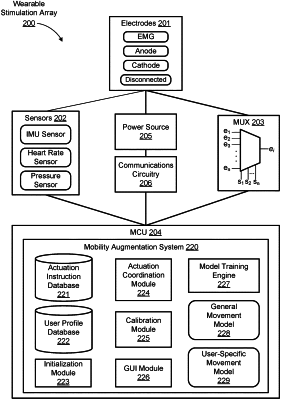| CPC A61N 1/36031 (2017.08) [A61B 5/0205 (2013.01); A61B 5/0533 (2013.01); A61B 5/1038 (2013.01); A61B 5/313 (2021.01); A61B 5/395 (2021.01); A61B 5/4848 (2013.01); A61N 1/0476 (2013.01); A61N 1/36003 (2013.01); G16H 40/63 (2018.01); A61B 2560/0223 (2013.01); A61B 2562/0219 (2013.01); A61B 2562/0247 (2013.01)] | 20 Claims |

|
1. A method comprising:
initializing a wearable stimulation array comprising a plurality of electrodes;
accessing a model configured to, for each of a plurality of movements, enable a corresponding electrical signal from a first set of the plurality of electrodes to a second set of the plurality of electrodes to stimulate the movement by a user;
in response to the use of the accessed model to stimulate a movement of the plurality of movements by the user using the wearable stimulation array, receiving feedback from the user indicating a measure of approval of the stimulated movement;
calibrating the wearable stimulation array by retraining the accessed model based on the received feedback to change, for at least the stimulated movement of the plurality of movements, one or more of the corresponding electrical signal, the first set of electrodes, and the second set of electrodes;
measuring the stimulated movement using one or more of inertial measurement unit (IMU) sensors or foot pressure sensors of the wearable stimulation array;
comparing the measured stimulated movement to a predetermined movement representative of neurotypical movement; and
scoring the measured movement based on one or more of the received feedback or the comparison, wherein the accessed model is retrained further based on the scoring.
|